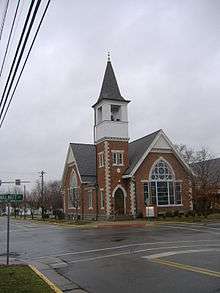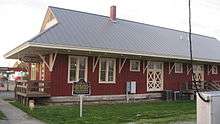Seymour, Indiana
Seymour is a city in Jackson County, Indiana, United States. The population was 17,503 at the 2010 census. Seymour holds particular significance due to the north/south and east/west railroads intersecting downtown.
Seymour, Indiana | |
|---|---|
 Location of Seymour in Jackson County, Indiana | |
| Coordinates: 38°57′26″N 85°53′20″W | |
| Country | United States |
| State | Indiana |
| County | Jackson |
| Townships | Jackson, Redding |
| Government | |
| • Mayor | Matthew Nicholson (R) |
| Area | |
| • Total | 12.14 sq mi (31.43 km2) |
| • Land | 12.13 sq mi (31.42 km2) |
| • Water | 0.01 sq mi (0.01 km2) 0.09% |
| Elevation | 602.91 ft (183.77 m) |
| Population | |
| • Total | 17,503 |
| • Estimate (2019)[3] | 19,959 |
| • Density | 1,645.15/sq mi (635.18/km2) |
| Time zone | UTC-5:00 (EST) |
| • Summer (DST) | UTC-4:00 (EDT) |
| ZIP code | 47274 |
| Area code(s) | 812 & 930 |
| FIPS code | 18-68832[4] |
| GNIS feature ID | 0443233[5] |
| Website | http://www.seymourcity.com/ |
The north/south line (the Jeffersonville, Madison and Indianapolis Railroad) was built in the 1840s and connected Indianapolis to the Ohio River at Jeffersonville. In 1852, Capt. Meedy Shields persuaded John Seymour into building the east/west railroad (the Ohio and Mississippi Railroad) through his land. In return, Shields named the area Seymour.
Aisin USA and Rose Acre Farms have their headquarters in Seymour, and Cummins has a plant in Seymour. The city is also the home of the largest high school gymnasium in the world.[6]
Geography
Seymour is located at 38°57′26″N 85°53′20″W (38.956350, -85.890068).[7]
According to the 2010 census, Seymour has a total area of 11.425 square miles (29.59 km2), of which 11.42 square miles (29.58 km2) (or 99.96%) is land and 0.005 square miles (0.01 km2) (or 0.04%) is water.[8]
Climate
The climate in this area is characterized by hot, humid summers and generally mild to cool winters. According to the Köppen Climate Classification system, Seymour has a humid subtropical climate, abbreviated "Cfa" on climate maps.[9]
Demographics

2010 census
As of the census[2] of 2010, there were 17,503 people, 6,907 households, and 4,514 families living in the city. The population density was 1,532.7 inhabitants per square mile (591.8/km2). There were 7,719 housing units at an average density of 675.9 per square mile (261.0/km2). The racial makeup of the city was 90.3% White, 1.3% African American, 0.2% Native American, 1.2% Asian, 0.1% Pacific Islander, 5.1% from other races, and 1.8% from two or more races. Hispanic or Latino of any race were 11.5% of the population.
There were 6,907 households of which 34.4% had children under the age of 18 living with them, 45.3% were married couples living together, 13.5% had a female householder with no husband present, 6.5% had a male householder with no wife present, and 34.6% were non-families. 28.1% of all households were made up of individuals and 9.8% had someone living alone who was 65 years of age or older. The average household size was 2.49 and the average family size was 3.01.
The median age in the city was 35.5 years. 25.3% of residents were under the age of 18; 8.7% were between the ages of 18 and 24; 28.6% were from 25 to 44; 24% were from 45 to 64; and 13.4% were 65 years of age or older. The gender makeup of the city was 48.7% male and 51.3% female.
2000 census

As of the census[4] of 2000, there were 18,101 people, 7,231 households, and 4,743 families living in the city. The population density was 1,670.3 people per square mile (644.7/km2). There were 7,709 housing units at an average density of 711.4 per square mile (274.6/km2). The racial makeup of the city was 93.40% White, 1.02% African American, 0.30% Native American, 1.43% Asian, 0.05% Pacific Islander, 2.93% from other races, and 0.86% from two or more races. Hispanic or Latino of any race were 4.85% of the population.
There were 7,231 households out of which 32.6% had children under the age of 18 living with them, 49.4% were married couples living together, 11.5% had a female householder with no husband present, and 34.4% were non-families. 28.5% of all households were made up of individuals and 11.6% had someone living alone who was 65 years of age or older. The average household size was 2.46 and the average family size was 2.99.
In the city, the population was spread out with 25.5% under the age of 18, 10.2% from 18 to 24, 31.4% from 25 to 44, 19.4% from 45 to 64, and 13.5% who were 65 years of age or older. The median age was 34 years. For every 100 females, there were 95.7 males. For every 100 females age 18 and over, there were 93.0 males.
The median income for a household in the city was $36,883, and the median income for a family was $43,357. Males had a median income of $30,638 versus $22,265 for females. The per capita income for the city was $18,222. About 8.0% of families and 10.0% of the population were below the poverty line, including 9.7% of those under age 18 and 11.6% of those age 65 or over.
Local media
History
| Historical population | |||
|---|---|---|---|
| Census | Pop. | %± | |
| 1860 | 966 | — | |
| 1870 | 2,372 | 145.5% | |
| 1880 | 4,250 | 79.2% | |
| 1890 | 5,337 | 25.6% | |
| 1900 | 6,445 | 20.8% | |
| 1910 | 6,305 | −2.2% | |
| 1920 | 7,348 | 16.5% | |
| 1930 | 7,508 | 2.2% | |
| 1940 | 8,620 | 14.8% | |
| 1950 | 9,629 | 11.7% | |
| 1960 | 11,629 | 20.8% | |
| 1970 | 13,352 | 14.8% | |
| 1980 | 15,050 | 12.7% | |
| 1990 | 15,576 | 3.5% | |
| 2000 | 18,101 | 16.2% | |
| 2010 | 17,503 | −3.3% | |
| Est. 2019 | 19,959 | [3] | 14.0% |
| Source: US Census Bureau | |||

Seymour was laid out and platted in 1852.[10]
Seymour was the site of the world's first train robbery, in which the train was moving. It was committed by the local Reno Gang, on October 6, 1866 just east of town. The gang was put into prison for the robbery, and later lynched at Hangman's Crossing outside town.
The Freeman Field Mutiny occurred in 1945, in which African-American members of the 477th Bombardment Group attempted to integrate an all-white officers' club at Freeman Army Air Corps Base. The mutiny later led to the integration of the United States military.
Farmers Club, First Presbyterian Church (Seymour, Indiana), T. Harlan and Helen Montgomery House, Seymour Commercial Historic District, Southern Indiana Railroad Freighthouse, and George H. Vehslage House are listed on the National Register of Historic Places.[11][12][13]
Education
Seymour Community Schools operates Seymour High School.[14]
Seymour has a public library, a branch of the Jackson County Public Library.[15]
Annual events
- Oktoberfest celebrates German heritage in Seymour. The festival is held the first weekend of October annually.
- Pepsi Plunge is annual age group swim meet that typically takes place in July of each year at the city pool in Shield's Park. This competitive event typically gathers near 1,000 competitive swimmers. The home-club for this swim meet is Seymour Swimming, coached by Dave Boggs. This swim meet is USA Swimming sanctioned.
- Scoop the Loop occurs the fourth weekend of every August. A car show and downtown parade are held on Friday and Saturday, respectively.
- The VJ Day Parade celebrates victory over Japan in World War II.
- Fear Fair Haunted House is open during weekends through the Fall every year, including Special events during Christmas & Valentine's Day.
Notable people
- Pat Calhoun, swimmer who competed in the 2000 Summer Olympic Games
- Paul Eggers, lawyer and two-time Republican nominee for governor of Texas in both 1968 and 1970
- Brian Fish, men's basketball head coach, Montana State
- Reno Gang, committed first train robbery in America, in Seymour
- Baron Hill, former Indiana 9th District U.S. Representative
- John Mellencamp, also known as John Cougar Mellencamp, musician, singer-songwriter, painter, and actor
- Teri Moren, women's basketball head coach, Indiana University
- Rip Rogers, retired professional wrestler and trainer
- Robert Shields, diarist whose personal diary earned him a place in the Guinness Book of World Records
- Katie Stam, 2008 Miss Indiana and Miss America 2009
- John Dittmer, award-winning civil-rights historian, author, and Professor Emeritus of DePauw University
- Rob Wiethoff, actor, John Marston in Red Dead Redemption and Red Dead Redemption 2
- The Elms, rock and roll band between 2000 and 2010
Nearby points of interest
- Freeman Municipal Airport is a public use airport, and it is located at 2.6 miles (4.2 km) south-southwest of the downtown. During the World War II, it was the Freeman Army Airfield.
- Muscatatuck National Wildlife Refuge[16] is located at 3 miles (5 km) east of the downtown.
- Southern Indiana Center for the Arts (including gallery of John Mellencamp oil paintings) Jackson-Washington State forest and Starve Hollow lake
References
- "2019 U.S. Gazetteer Files". United States Census Bureau. Retrieved July 16, 2020.
- "U.S. Census website". United States Census Bureau. Retrieved 2012-12-11.
- "Population and Housing Unit Estimates". United States Census Bureau. May 24, 2020. Retrieved May 27, 2020.
- "U.S. Census website". United States Census Bureau. Retrieved 2008-01-31.
- "US Board on Geographic Names". United States Geological Survey. 2007-10-25. Retrieved 2008-01-31.
- https://www.indystar.com/story/sports/2019/03/08/indianas-largest-high-school-basektball-gym-changes-after-seating-count/3087204002/
- "US Gazetteer files: 2010, 2000, and 1990". United States Census Bureau. 2011-02-12. Retrieved 2011-04-23.
- "G001 - Geographic Identifiers - 2010 Census Summary File 1". United States Census Bureau. Archived from the original on 2020-02-13. Retrieved 2015-07-29.
- Climate Summary for Seymour, Indiana
- History of Jackson County, Indiana: From the Earliest Time to the Present, with Biographical Sketches, Notes, Etc., Together with an Extended History of the Northwest, the Indiana Territory and the State of Indiana. Unigraphic. 1886. p. 459.
- "National Register Information System". National Register of Historic Places. National Park Service. July 9, 2010.
- "National Register of Historic Places Listings". Weekly List of Actions Taken on Properties: 9/20/10 through 9/24/10. National Park Service. 2010-10-01.
- "National Register of Historic Places Listings". Weekly List of Actions Taken on Properties: 12/27/10 through 12/30/10. National Park Service. 2011-01-07.
- "Seymour schools". Seymour Community Schools. Retrieved 15 March 2018.
- "Locations & Hours". Jackson County Public Library. Retrieved 8 March 2018.
- http://midwest.fws.gov/Muscatatuck/ Muscatatuck National Wildlife Refuge
